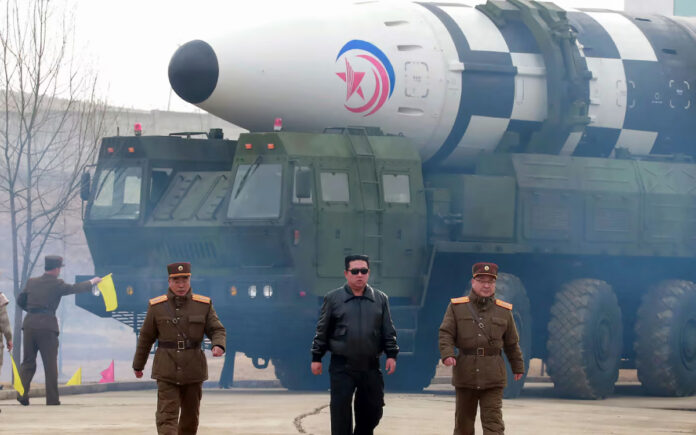Seoul: North Korea launched what appears to be its longest intercontinental ballistic missile (ICBM) test to date on Thursday. South Korea warned that Pyongyang might seek advanced missile technology from Russia in exchange for providing troops to aid Russia’s war effort in Ukraine.
The missile was launched on a high-angle trajectory from an area near North Korea’s capital, landing roughly 300 km (190 miles) west of Japan’s Hokkaido, marking North Korea’s longest-ever recorded ICBM flight time. The launch occurred just a day after South Korea reported signs that North Korea could test-launch an ICBM or even conduct a seventh nuclear test near the U.S. presidential election, with the potential aim of showcasing its military advancements.
South Korea, Japan, and the U.S. swiftly condemned the launch, which has heightened international alarm as reports suggest North Korea may have sent thousands of troops to Russia in support of its campaign in Ukraine. “It is believed the North Korea ballistic missile is a long-range ballistic missile fired at a high angle,” South Korea’s Joint Chiefs of Staff announced in a statement. Later, they indicated that the missile might have used a newly developed solid-fuel booster.
Both South Korean and Japanese authorities recorded an unprecedented flight time of 87 minutes, surpassing the previous record of 73 minutes from North Korea’s ICBM test in December 2023. Japan’s government reported that the missile reached an altitude of 7,000 km and traveled 1,000 km in distance, identifying it as an ICBM-class missile.
A U.S. official confirmed to the international news agency Reuters that the missile was indeed an ICBM. North Korea’s choice to use a “lofted” trajectory, where the projectile flies on a sharply raised angle, is often intended to assess thrust and stability over shorter distances to avoid any significant geopolitical escalation that might arise from a missile landing far into the Pacific Ocean.
North Korea’s last ICBM launch in December, known as the Hwasong-18, utilized solid fuel and a road-mobile launcher, achieving a flight time and trajectory that could imply a range of up to 15,000 km (9,300 miles) on a standard trajectory—potentially reaching any location within the mainland United States.
North Korea-Russia Defense Collaboration
This latest launch follows strong international backlash over reports suggesting North Korea deployed around 11,000 troops to Russia, with an estimated 3,000 positioned near Ukraine’s western frontlines. Although Moscow and Pyongyang have yet to directly confirm these deployments, Russia’s U.N. Ambassador Vassily Nebenzia recently argued that allies, including North Korea, should be permitted to aid Russia in Ukraine if Western nations are allowed to assist Kyiv.
The alleged deployment has raised security concerns across the region, with U.S. Secretary of Defense Lloyd Austin and his South Korean counterpart Kim Yong-hyun condemning the action during a meeting in Washington just hours before the North Korean missile test. Austin expressed that North Korea’s military involvement in Russia’s conflict could prolong the ongoing war in Ukraine, which has lasted for over two and a half years, and potentially escalate it further.
Also Read | Taiwan Suspends Operations as Powerful Typhoon Kong-rey Approaches
South Korean officials are concerned that the deployment could provide North Korean forces with valuable combat experience in modern warfare, which might ultimately benefit Pyongyang. In return, Moscow may offer technology transfers in areas such as tactical nuclear weapons, ICBMs, ballistic missile submarines, and military reconnaissance satellites, according to South Korea’s defense ministry.
Shin Seung-ki, head of research on North Korea’s military at the Korea Institute for Defense Analyses, suggested that the missile’s prolonged flight time could result from enhanced booster performance, possibly aided by Russian technology. “North Korea will want to keep getting help like this, because it saves time and costs while improving performance and upgrading the stability of weapons systems,” he noted.
Also Read | New Sanctions: U.S. Hits Russia’s Allies with Broad Restrictions on Technology Suppliers
With mounting pressure over its alignment with Russia, North Korea may intend to signal that it will not back down in the face of international condemnation. “The intention may be to show that it will not bow to pressure, that it will respond to strength with strength, and also to seek some influence on the U.S. presidential election,” Shin added.



